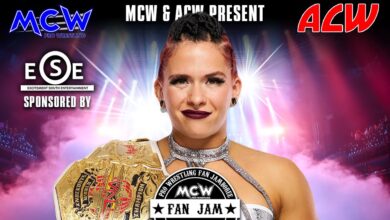Evolution Progress Report: WWE Women Receive Significantly Less Airtime
Stephanie McMahon posted a tweet shaming the statistic that four percent of sports media coverage goes to women’s sports. How does WWE stack-up?
Evolution Progress Report evaluates the progress of women’s wrestling, in all promotions, across the board. By keeping an eye out on the status of the landscape, wrestling promotions will be held accountable for promises made, movements started, and statistics given.
Earlier this week, WWE’s Chief Brand Officer Stephanie McMahon posted a tweet on her personal Twitter account showing support for female empowerment organization SheIs and the “#WomenWorthWatching” movement.
Only 4% of media coverage is dedicated to women’s sports – that needs to change. Let’s show the world that women are worth watching! @TeamSheIS #WomenWorthWatching https://t.co/YwuGwDr6JD
— Stephanie McMahon (@StephMcMahon) August 13, 2019
WWE and SheIs have announced their partnership in the past, teaming up to increase fan engagement and support of women’s sports.
The tweet from McMahon drew ire from wrestling fans, with the vast majority upset that McMahon would shame a small coverage percentage, when WWE features their own female superstars so little on their televised shows.
The number is shockingly small, especially considering the facts. According to the Tucker Center for Research on Girls & Women in Sport at the University of Minnesota, 40 percent of all sports participants are female, and 43 percent of sports scholarships go to women.
The percentage stated in McMahon’s tweet came from an evidence-based research project done by the Tucker Center, “Media Coverage and Female Athletes”. The project, completed in the form of a documentary, used findings from a research article entitled “‘It’s Dude Time!’: A Quarter Century of Excluding Women’s Sports in Televised News and Highlight Shows”.
The research conducted by Cheryl Cooky, Ph.D. and her colleagues covered a span of twenty-five years. Researchers watched local L.A. news programs, as well as nationally broadcasted sports news shows like Sportscenter, and counted how many times news featuring women athletes and women’s sports were mentioned. Though the percentage changed from program to program, the team’s findings saw a decline in media coverage of women’s sports, and ignited debate on what role, if any, media plays in representing and eliciting interest in sports.
The research last gathered samples in 2014, so a small and quick sample was personally taken to test the validity of the numbers. Within the major networks (ABC, CBS, NBC, FOX, EPSN) that features sports shows, podcasts and website sections, only 6.9 percent of sports media coverage was given to female athletes, since the beginning of August.
The looming question is, however, does WWE have any business demanding more support for women’s sports, with how little they support their own female athletes?
To properly answer that question, I had to conduct my own research on airtime given to women wrestlers in WWE programming. I excluded matches aired prior to WWE Evolution, as that is when WWE put focus on the women’s wrestling “evolution”. Raw and SmackDown were the only shows included in the research, as they are the only shows that are aired nationally, on a cable network. Airtime was measured in match length, bell to bell, and match lengths were derived from four separate websites: profightdb.com, cagematch.net, prowrestling.fandom.com, and wrestletalk.com.
Dark matches were not aired on television, and therefore were not counted. Mixed tag team matches were counted for both genders.
Since Oct. 28, there have been 42 episodes of Raw. The total length of all matches aired on national television in those 42 episodes is 35 hours, 36 minutes and 39 seconds. Of that total match airtime, women accounted for eight hours, 51 minutes and 11 seconds; a rough 21.4 percent of total match airtime.
Plenty of people would argue that Ronda Rousey was heavily supported and pushed by WWE, so I was intrigued to see if there would be any difference in airtime once Rousey left for vacation, after WrestleMania. Before WrestleMania, women were on air for five hours, 37 minutes, and 22 seconds; 27.5 percent of total airtime before WrestleMania, but after Evolution. After WrestleMania, until present, women were on air for three hours, 13 minutes, and 49 seconds; 21.4 percent of airtime. The difference adds up to two hours, 24 minutes, and 32 seconds. Though the numbers can’t conclude without-a-doubt that Rousey was the reason for more airtime, it’s safe to assume it had something to do with it.
SmackDown also has had 42 episodes air, since Evolution. The blue brand aired 26 hours and 33 seconds worth of wrestling matches, since last October. Of that time, women’s matches accounted for five hours, three minutes, and 28 seconds; the even worse stat of 19.4 percent. It’s shocking that SmackDown hasn’t had more even match airtimes between men and women, because of their upcoming move to FOX.
The total airtime between Raw and Smackdown, is 61 hours, 37 minutes and 12 seconds. Women’s matches accounted for 13 hours, 54 minutes, and 39 seconds. This airtime calculates to be 22.6 percent of total match time aired on a cable network in WWE programming, since Oct. 28 of last year.
While 22.6 percent is certainly higher than four percent, it doesn’t excuse the clear inequality of match lengths. Arguments were made that pay-per-views are where WWE airs out their best talent, and so the percentage of airtime women’s wrestling would get would certainly increase.
In the 15 WWE events that main card wrestlers have participated in, there has been a total of 26 hours and 35 minutes of match time, from bell to bell. Of that time, women’s matches accounted for six hours, 45 minutes and 50 seconds; 25.4 percent of total airtime. Sure, it’s slightly higher than the weekly programming coverage, but not by a considerable percentage.
The argument could be made that a length of a match is not necessarily an indicator of the quality of the match, meaning a longer match isn’t always better than a shorter one. While this may be true, it is indicative of how invested a promotion is in the wrestlers involved in the match. It’s clear by the ratio of men to women on WWE’s main roster, and by the time allotted to the men of WWE for matches, that the male superstars are invested in more heavily than the women.
If WWE insists on continuing their push for a “women’s evolution”, and patting themselves on the back every time a strive towards equality is made, they should look closely at their own numbers.
By leveling the playing field, utilizing the roster they already have, and developing strong female talent in NXT, WWE will have made the strives they need. WWE has a partnership with SheIs, so supporting and garnering support for women’s wrestling should be near the top of their list.




